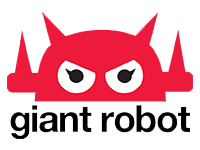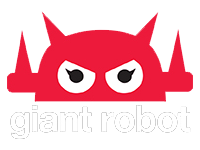Giant Robot Store and GR2 News
TOKYO ~ Two years ago this week explosions and meltdowns at Fukushima Daiichi Nuclear Genpatsu in northeastern Japan created this nation’s worst man-disaster. The ability to perform heavy duty repair work in the highly radioactive environs of a damaged nuclear reactor was one of the first obstacles that nuclear engineers faced at Fukushima Daiichi. To outside observers of Japan, the answer seemed simple: send in Japan vaunted robots. But the myth of Japanese robot supremacy was blown to bits by Fukushima Daiichi. Yes, Japan had talking robots, robot children, sexy fembots, robot pets and manufacturing robots, but it hadn’t produced machines mobile, powerful or agile enough to be of any use in a real world disaster scenario. So, the Japanese ate some humble pie and called Boston-based iRobot, maker of the vacuuming robot Roomba, which sent Japan its PackBot and Warrior robots which became the first robots to enter and inspect Fukushima’s Daiichi’s damaged reactors. [youtube]j7r29YxICBw[/youtube] But since Fukushima Daiichi, Japan has indeed stepped up its robotics game. Mitsubishi, Toshiba, Honda, Panasonic, and Toyota have all boosted funding and investments of their proprietary bot expertise, and the Japanese government has also increased support toward university robotics laboratories and private-public partnerships. So, if the triple meltdowns had a silver lining, it was the Japanese robotics industry’s new focus away from cute machines and toward capable ones. Akihabara News has a great article by Reno J. Tibke of how Fukushima sparked Japan’s robot renaissance. ~Rachel Roh
Continue reading
[Click to enlarge] SAN JUAN CAPISTRANO, Calif. ~ This week there’s been talk of restarting the Edison International-operated nuclear reactors at San Onofre. Located between Los Angeles and San Diego, the two operational pressurized water reactors there ~ units #2 and #3 ~ have been shut down since January 2012, when an inspection found that new pipes that carry steam to and from the reactor’s generators showed unexpected corrosion less than two years ago after they were retrofitted. Any other time in the atomic age, the public might have just shrugged and accepted all the assurances of the giant utility. “Not to worry, folks.” But it’s only been 15 months since the triple meltdowns at Fukushima Daiichi, and three of the Japanese reactors there are still leaking radioactive becquerels and bucky balls of toxic isotopes and a tsunami-shattered fourth reactor building houses some 1,500 spent fuel rods that some say could create another nuclear disaster that will dwarf the one that the beleaguered Tokyo Electric Power Company (TEPCO) and the Japanese government will be battling for the unforeseen future. The movement against the restarting of San Onofre #2 and #3 is growing. Warnings by the Southern California power companies that the absence of cheap and clean nuclear energy might cause rolling blackouts and limited time for junior on the Xbox don’t seem to carry the same fuzzy feelings as they did BF ~ Before Fukushima. One month after Japan’s triple 3-11 disasters, our friends over at Gizmodo published a timely story entitled “How a Fukushima-Level Disaster Would Affect You in New York, L.A. or Chicago.” The story featured some maps that were chilling then and that are even more compelling today factoring in what we didn’t know about the on-going nuclear mishaps in Japan. Gizmodo notes that while Japan opted for a 30-kilometer or 18.6-mile radius long-term evacuation zone, U.S. scientists tipped their hand last March when they advised any American citizen inside an 80-kilometer ( 49.7 mile) radius of Fukushima Daiichi to leave. If that same policy were applied in the case of meltdowns at reactors near the three top urban populations centers of the U.S. ~ New York City, Los Angeles and Chicago, this would be the scenario, according to Gizmodo: ♣In the worst case of an meltdown at Indian Point Nuclear Station in Buchanan, NY, more than 20 million people in the metro area would have to be evacuated, leaving the city deserted, from Long Island to the Bronx. ♣If a Fukushima-like accident were to hit San Onofre, Southern California, although the city of Los Angeles itself would fall outside the evacuation zone, some 15 million souls would be told to evacuate from most of Orange Counnty, Huntington Beach, Long Beach, Rancho Palos Verdes to the north; greater San Diego to the south; Fontana, Whittier and Pomona to the east; and Catalina Island and Pacific Ocean to the west. ♣A disaster at either Dresden Nuclear Power Station in Dresden, IL or Braidwood NPP, Braidwood, IL outside Chicago...
Continue reading
Pacific bluefin tuna migrating last year from coastal Japan to the waters off Southern California contained radioactive cesium isotopes from the Fukushima nuclear disaster, scientists reported Monday. This news sent the Twitterverse careening out of control for a time, but what are the facts? The amount of radioactivity in the fish was one-tenth the level the U.S. and Japan consider dangerous, and likely posed no public health hazard or risk to people who ate the seafood, the scientists said. But the study showed for the first time that migrating sea life rapidly brought traces of radioactive elements from the damaged Fukushima Daiichi nuclear reactors across vast distances. [Read more about tuna and radiation: HuffPo ~ Bluefin Tuna Radiation: Is There A Health Risk? / The Wall Street Journal ~ U.S. Tuna Has Fukushima Taint
Continue reading



